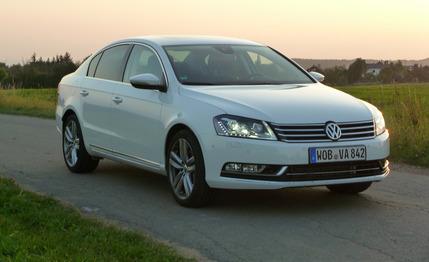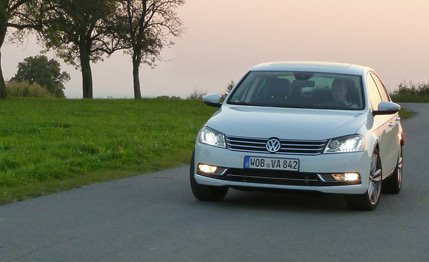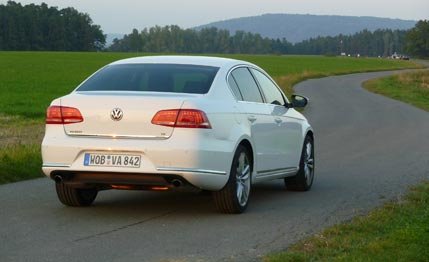 First Drive Review
First Drive Review
Volkswagen has shifted a lot of its attention to the U.S. market, so much so that we now get a dedicated Passat. Should we be flattered, or should we lament the fact that we don’t get the European model?
We like the new-for-’12, U.S.-built Passat, which rides on a longer wheelbase and has unique sheetmetal, as evidenced by its comparison-test victory against a Honda Accord V-6 and a turbocharged Hyundai Sonata last October. But whereas our car is large and roomy with Americans in mind, the European Passat remained closer in size to its predecessor when it was redesigned for 2011, carrying over its 106.8-inch wheelbase. That’s 3.6 inches shorter than the U.S. Passat’s.
Top-Shelf Forbidden Fruit
We went straight to the top of the tree for our drive, plucking free the loftiest Euro Passat, which packs a 300-hp, 3.6-liter VR6 and 4MOTION all-wheel drive. The VR6 is essentially the same engine that’s available in the U.S.-market Passat, albeit with an additional dollop of horsepower. The Euro engine makes 300 hp at 6600 rpm; the U.S. Passat is rated at 280 hp at 6200 rpm. Maximum torque is the same at 258 lb-ft, but peak twist is available over a slightly broader rev range in the Euro-spec car, from 2400 to 5300 rpm instead of 2500 to 5000. The VR6 routes its power through the same dual-wet-clutch six-speed automatic transmission on both continents.
The VR6 AWD European Passat weighs in at a claimed 3950 pounds; VW says it can hit 62 mph in 5.5 seconds. Our European test car’s top speed was governed at 155 mph, and we repeatedly reached that speed without effort. (The U.S. VR6 is governed to 126 mph.) We like the flexible, smooth engine and its slightly aggressive sound. As on our car, the powerplant and the six-speed dual-clutch box make a great team; the DSG offers whip-quick shifts (they can be manually initiated with paddles on the steering wheel), a trait that makes the most of the engine’s linear power delivery. In terms of fuel consumption, however, the Euro car doesn’t fare particularly well. We found it difficult to do better than an indicated 21 mpg. In the aforementioned comparo, we measured 27 mpg with the American Passat and the Accord and 26 with the Sonata.

As the Passat is fitted with all-wheel drive, torque steer is a nonissue. This European model remains neutral while cornering, but that’s not to say you can steer with the go pedal. The 4MOTION setup is a front-biased system with a Haldex clutch that can transfer up to 50 percent of the torque to the rear. The “cross differential system” (XDS) stability control incorporates a brake-based “limited slip” function for the front wheels that somewhat successfully simulates the real thing when accelerating out of corners. The electromechanical power steering is exceptionally light yet provides sufficient information about road conditions. There is an adaptive, adjustable damper system called dynamic chassis control (DCC) that adjusts steering, braking, and acceleration. Leaving DCC in auto works well, as neither comfort nor sport mode is particularly extreme. At a minimum, having the option to firm things up addresses one of our dynamic complaints about the car: Its suspension is too soft for enthusiastic driving.
Make Your Own
Customers in the Old World love to pore over price lists and spend endless hours with online configurators to create their own unique cars. Good for those folks, then, that this latest European Passat can be outfitted with an abundance of assistance systems and options typically associated with the luxury-car segment. (There are more bells and whistles available even than on the U.S.-market CC, which could be considered our finest Passat.) Among the available gadgetry: a driver’s-side massaging seat, a sensor system that allows you to open the trunk at the wave of a foot, a 600-watt stereo system that can be spec’d over and above navigation and multimedia connectivity, a lane-keeping system that operates partly via the steering, a blind-spot alert system, and a low-speed automatic braking system. Adding to the luxury-class feel was the fact that our Passat was extremely quiet, even during top-speed runs. The rear subframe is isolated by rubber bushings, and there is extra noise insulation in the doors and dashboard as well as acoustical material in the windshield. The U.S. Passat doesn’t have these items, and although it is quiet, the European model takes silence seriously.
Xenon lights no longer are available on the U.S. version, but the European Passat VR6 is available with Bi-Xenon units; ordering them adds LED taillamps. The Euro Passat has an electric parking brake, the U.S. model doesn’t; the interior of the European model is trimmed with real wood, the U.S. model’s isn’t. The aforementioned DCC system isn’t offered in the U.S. One check in our favor: The Euro car’s rear seat is not as spacious as the Chattanooga-built Passat’s.

High Refinement, High Price
Although the U.S. Passat is a competent car at the top of its class, its German-built sibling offers a measure of refinement beyond the competition, as well as many a class above. In this top-of-the-line configuration, the European-market Passat is perfectly suited for high-speed, long-distance cruising. Good performance, a comfortable chassis, and scads of available goodies transform what is essentially a practical family car into a reasonable alternative to lower-spec, mid-size luxury cars. Even better: This model is also available as a station wagon.
Before you rush to write VW North America with your complaints, however, you might wish to consider the price. In Germany, the Passat 4MOTION VR6 begins at €35,441 before taxes, or about $46,000. Load it with options, as here, and you reach almost €50,000, or close to $65,000. High pricing for its segment, of course, is what had long limited Passat volumes in America and drove the decision to create a less expensive version to be sold here. The U.S. Passat VR6 starts at $29,765, and an entry-level five-cylinder at $20,765. Those prices should please American Passat buyers, as should the excellent car they get in return. We like the Euro Passat, but perhaps we should feel flattered after all.